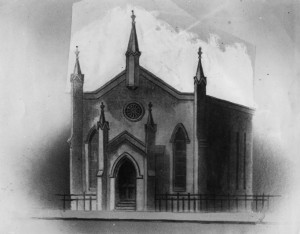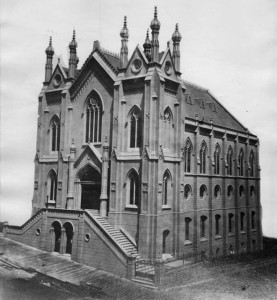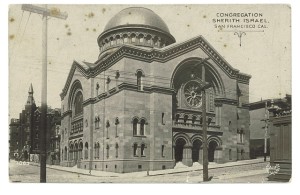Congregation Sherith Israel
Stockton Street
Following the formation of the first two congregations of San Francisco in early April 1851, Congregation Sherith Israel (Polish) and Congregation Emanu-El (Bavarian & Alsatian), both congregations used rented quarters.
Three years later, both congregations erected their own synagogue buildings.
Congregation Sherith Israel laid their cornerstone on August 6, 1854, on the east side of Stockton Street between Vallejo and Broadway.
Congregation Emanu-El had preceded it by two weeks with its cornerstone rites.
However, Congregation Sherith Israel completed and consecrated its structure on September 8, 1854, six days before the Congregation Emanu-El opening ceremony was held.
The Sherith Israel lot was 69 by 40 feet in size. The Trustees of the Congregation borrowed $6,000 on August 5, 1854 to pay the building expenses. The rate of interest was two and one quarter percent per month (27%/yr.).
Those who signed the mortgage for the money were Israel Solomon, president of the congregation; Barnet Reesling, vice president and treasurer; and Henry M. Lewis, Louis Myers, Alexander Friedlander, Judah P. Davies, and Tobias Hochstein, trustees.
The Stockton Street synagogue was used for sixteen years until in 1870, when a new, much larger and grander structure was built at Post and Taylor.
By that time, Reform tendencies were evident in the congregation. A dissident/Orthodox group elected to stay with the old Stockton Street Synagogue, forming a new Orthodox Congregation: Shaare Zedek.
The Orthodox group was for some time headed by Abraham Walters, an English Jew of Polish descent, as were many of the Sherith Israel members. Walters had presided over the meetings in the Spring of 1851 intended to establish a United San Francisco Jewish Congregation, but out of which the twins, Emanu-El and Sherith Israel, emerged.
Post & Taylor
By the late 1860’s, the synagogue of Congregation Sherith Israel on Stockton Street had been outgrown, and a lot at the corner of Taylor and Post was purchased.
A structure of 62 by 105 feet was built, in the decorative Gothic style of the 14th century.
The cornerstone of the building was laid on March 11, 1870, with the congregation’s secretary, Isaiah Cohn, reading a historical sketch which stated, “In the early part of 1851, a body of Israelites…organized” Sherith Israel.
Less than 6 months later, the synagogue was consecrated, with its Torahs being carried in a procession from the Stockton Street building.
Rabbi Aron J. Messing officiated.
The interior of the new Synagogue was mainly of rosewood and paneled with California laurel. The pews were cushioned in crimson velvet.
The synagogue was said to have been, “a work of which the Israelites of San Francisco may well be proud.”
At the consecration, the men “kept their hats [kippot] on,” it being a number of years before Reform practices were instituted. The diamonds worn by the ladies reportedly flashed everywhere in the sanctuary, which seated 720.
The sale of pews two days after the consecration raised over $47,000, almost enough to pay the balance owed for the new structure. President Charles Meyer gave $2,450 for his seats; Mr. Levi Shilling (of spice fame) gave $1,080; Mr. John M. Martin (a Sephard who was a San Francisco County Supervisor) gave $850.
The 1870 Synagogue was used until 1904, when the Congregation occupied its present grand structure on California at Webster.
California & Webster
Sources
- Norton B. Stern, “Sherith Israel Synagogue,” Western States Jewish History 42/2.
- Norton B. Stern, “Sherith Israel’s Second Synagogue,” Western States Jewish History 42/2.



